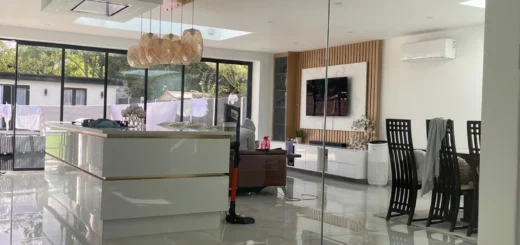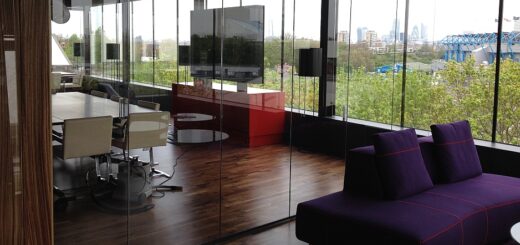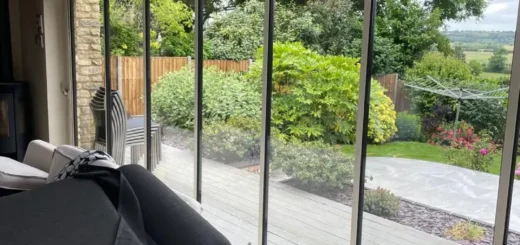External Concertina Doors: Design and Style Guide
Table of Contents
What Are External Concertina Doors
External concertina doors, also known as bifold patio doors, let you open up entire walls of your home by folding multiple glass panels together like a paper fan. Each panel connects to the next via robust hinges, creating a train of glass sections that stack neatly to one or both sides of the opening.

How Concertina Door Panels Move and Stack
The smooth movement of concertina glass doors relies on precision-engineered tracks and roller systems. Top-hung designs support the weight of each panel from above, while bottom-rolling systems use wheels that glide along the base track. Most British installations favour top-hung systems because they stay cleaner and move more smoothly in our wet climate.
Running along these tracks, the door panels fold in sequence thanks to specially designed hinges and rollers. When fully opened, exterior concertina doors can stack flat against your walls, taking up minimal space. The panels fold in a zigzag pattern, with each one pulling the next along as you open or close them.
Comparing Aluminium vs uPVC External Concertina Doors
Aluminium frames dominate the external concertina doors market for good reasons. The strength of aluminium allows for slimmer frames and larger glass areas compared to uPVC, while resisting warping and maintaining smooth operation year after year. Though uPVC costs less initially, aluminium’s durability and slim profiles make it the superior choice for living spaces where views and light matter most.
Modern powder-coated aluminium withstands Britain’s variable weather without corroding or needing regular maintenance beyond occasional cleaning. Unlike uPVC, aluminium frames keep their shape even in extreme temperatures, preventing sticking or jamming during summer heatwaves or winter cold snaps.
Aluminium’s inherent rigidity allows for taller and wider panels without sagging, plus thinner frames that maximise glass area. While uPVC frames must be thicker to achieve adequate strength, aluminium can support large panes of glass with minimal visual interruption. The metal’s stability prevents the seasonal expansion and contraction that often plagues plastic frames.
Design Options for External Concertina Doors
Modern manufacturing lets you customise almost every aspect of external concertina doors, from frames to glazing. Today’s options range from ultra-slim aluminium profiles that nearly vanish from view to chunky traditional designs that suit period properties.
Frame Styles and Sizes
Slim frames dominate contemporary external concertina doors, with the thinnest profiles measuring just millimetres across. These minimal frames work particularly well in modern homes where large glass panels take centre stage. For traditional properties, wider frames provide the robust appearance many homeowners prefer.
Panel widths play a vital part in the overall design. Narrower panels create a more traditional appearance with multiple vertical lines when closed, while wider panels suit modern aesthetics with fewer visible breaks. Most bespoke bifold doors offer panels ranging from around half a metre to over a metre wide.
Popular Frame Configurations
Setting up external bifolding doors involves choosing how the panels stack when open. Layouts with odd numbers of panels typically have a traffic door – a conventional hinged door used for quick access without opening the whole system. Even-numbered configurations often split in the middle, with panels stacking to each side.
Glass Types and Georgian Bars
The choice of glass changes how external concertina doors look and perform. Double glazing comes standard, with triple glazing offering improved energy efficiency in exposed locations. Clear glass provides uninterrupted views, while frosted or obscure options add privacy where needed.
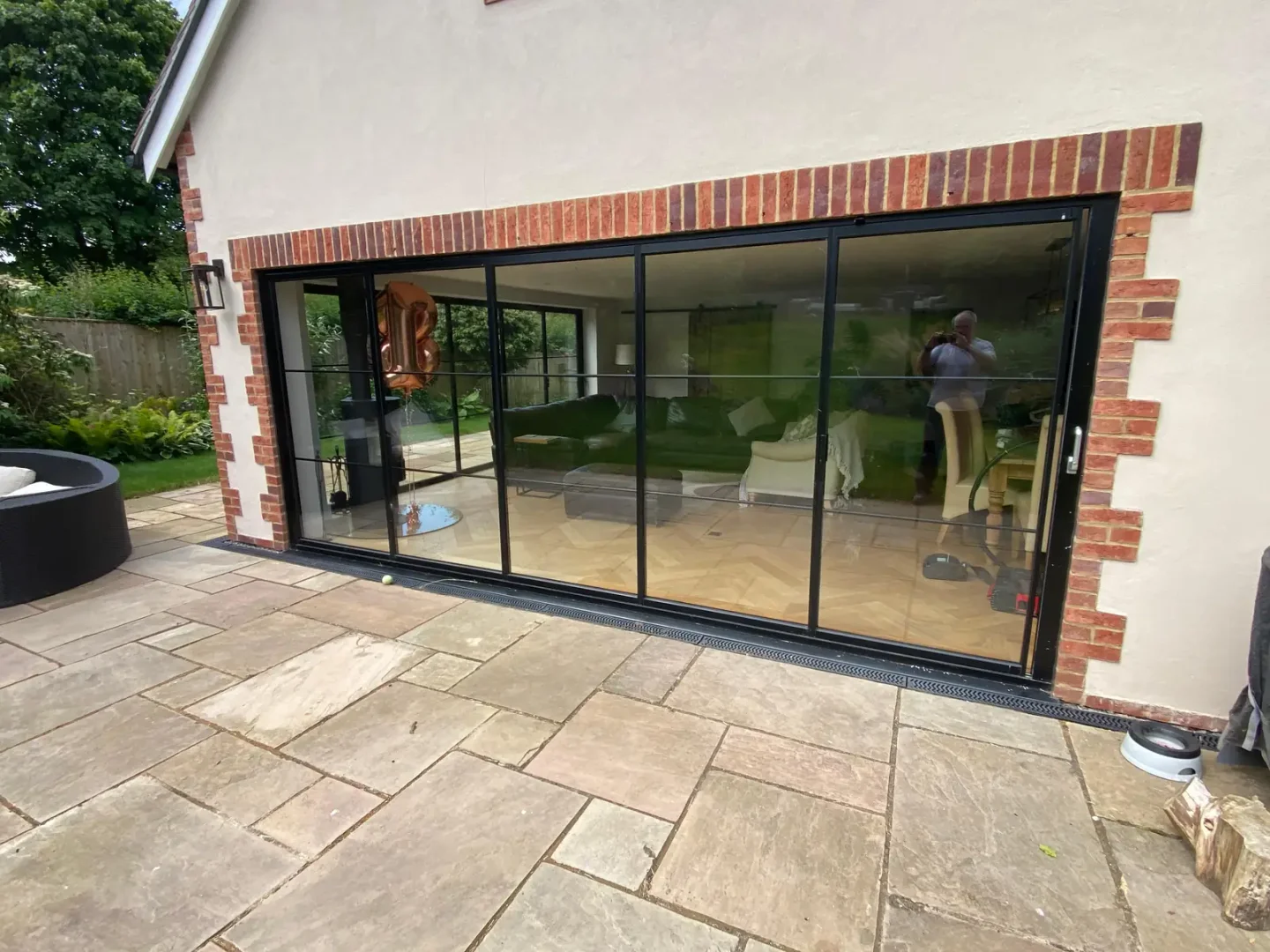
Georgian bars can give a traditional twist to modern materials. Authentic period looks use bars between the glass panes rather than stick-on versions that can peel off over time. The bars divide large glass areas into smaller panes, matching older architectural styles while keeping modern thermal performance.
Many exterior concertina doors now feature solar control glass that reduces heat gain in summer without blocking natural light. Low-iron glass removes the slight green tint found in standard glazing, creating crystal-clear views of gardens and outdoor spaces.
Corner Units and Special Configurations
Corner installations remove supporting posts when open, creating striking architectural features. These specialised external concertina doors need careful planning to ensure structural support when closed, but their impact on open-plan living makes them increasingly popular.
Angled installations work around bay windows or unusual wall layouts. Rather than forcing straight lines onto curved architecture, these adapted designs follow existing building shapes. Special corner units can open up two walls at once, with panels meeting at custom angles rather than standard ninety-degree corners.
Non-standard shapes accommodate sloping ceilings or unusual openings. Trapezoid panels can follow roof lines, while arched heads match period features in older properties. Manufacturing techniques now allow these complex shapes without compromising on smooth operation or weather protection.
Hardware Finishes
Handle designs range from minimal flush levers to ornate period-style hardware. Matching the finish to other architectural elements helps create a cohesive look – brushed steel suits contemporary spaces, while antique brass or bronze complement traditional homes.
Hinges and tracks need similar attention to detail. Exposed hinges can become design features in themselves, especially in industrial-style spaces. Hidden rollers and flush track systems offer cleaner lines for minimal modern designs.
Multi-point locking systems provide security without cluttering the frames. The best designs hide their mechanisms within the frame while still offering easy operation. Intermediate handles on wider doors make opening and closing more convenient, particularly for taller installations.
Colours and Finishes for External Concertina Doors
British homeowners increasingly opt for bold colours in their external concertina doors, moving away from traditional white or natural aluminium. Dark shades now dominate new installations, with anthracite grey leading the trend across modern and period properties alike.
Dark Colours and Anthracite Grey
Anthracite grey has become the default choice for external doors in recent years, particularly in contemporary homes. This deep, neutral shade works well against brick, stone, and rendered walls while hiding dirt better than lighter colours. Many architects specify black aluminium bifold doors for ultra-modern projects, creating stark contrasts with light-coloured walls.
Dark bronze and graphite finishes offer subtle alternatives to pure black or grey. These warmer tones suit period properties where stark modern colours might look out of place. Deep greens and blues have gained popularity too, adding personality without overwhelming the building’s original character.
Colour Psychology in Architecture
Paint finishes change appearance throughout the day as natural light shifts. Morning sun brings out warm undertones in anthracite finishes, while evening light emphasises cooler grey notes. Lighter surfaces reflect more sunlight into your entertaining space, though darker colours often frame garden views more effectively.
Textured vs Smooth Finishes
Powder-coated aluminium exterior concertina doors come in textured or smooth finishes. Textured surfaces hide minor scratches and fingerprints better than gloss or satin options, making them practical for busy family homes. Fine-grain textures provide grip without collecting dirt, while metallic finishes add subtle sparkle under direct light.
Woodgrain effects have improved hugely in recent years. Modern texturing techniques create realistic oak, pine, and walnut appearances that maintain the strength of aluminium. These finishes let homeowners match the look of timber while avoiding its maintenance requirements.
Matte finishes have surged in popularity, offering sophisticated alternatives to traditional gloss. The flat appearance reduces glare and softens reflections, particularly beneficial in south-facing installations. Many exterior concertina doors now feature dual finishes – different colours or textures inside and out.
Matching Hardware Finishes
Handle colours should complement rather than match frame finishes exactly. Stainless steel hardware stands out beautifully against dark frames, while bronze or brass options add warmth to grey or black doors. Powder-coated handles in matching frame colours offer the most subtle appearance, letting glass and views take centre stage.
Track covers and hinges deserve equal attention to detail. Visible hardware elements can become deliberate design features or disappear into the frame depending on colour choice. Many manufacturers now offer custom colours for all external hardware, ensuring complete coordination across every component.
The newest powder-coating techniques produce surfaces that resist fading and weathering. Premium finishes often carry warranties against colour change, essential for expensive installations like external concertina doors. Marine-grade treatments provide extra protection in coastal areas where salt spray accelerates wear.
Special Effect Finishes
Metallic powder coatings add depth through subtle sparkle effects. These finishes change character as viewing angles shift, creating dynamic surfaces that catch light differently throughout the day. Fine metallic particles in the coating reflect sunlight without producing harsh glare.
Anodised finishes provide unique metallic appearances impossible to achieve with paint. These electrochemically treated surfaces resist scratches while maintaining their distinctive sheen. Though colour options remain limited compared to powder coating, anodised aluminium offers unmatched durability in harsh environments.
Raw industrial finishes suit warehouse conversions and modern architectural styles. Untreated aluminium develops a protective patina over time, though most UK installations require protective coating against our wet climate. Some manufacturers offer pre-weathered effects that mimic naturally aged metal without waiting years for patina development.
External Concertina Doors for Different House Styles
Adapting external concertina doors to match your home’s architecture requires careful attention to detail. Period properties need different design approaches than modern homes, while garden rooms and extensions often suit different styles than main living areas.
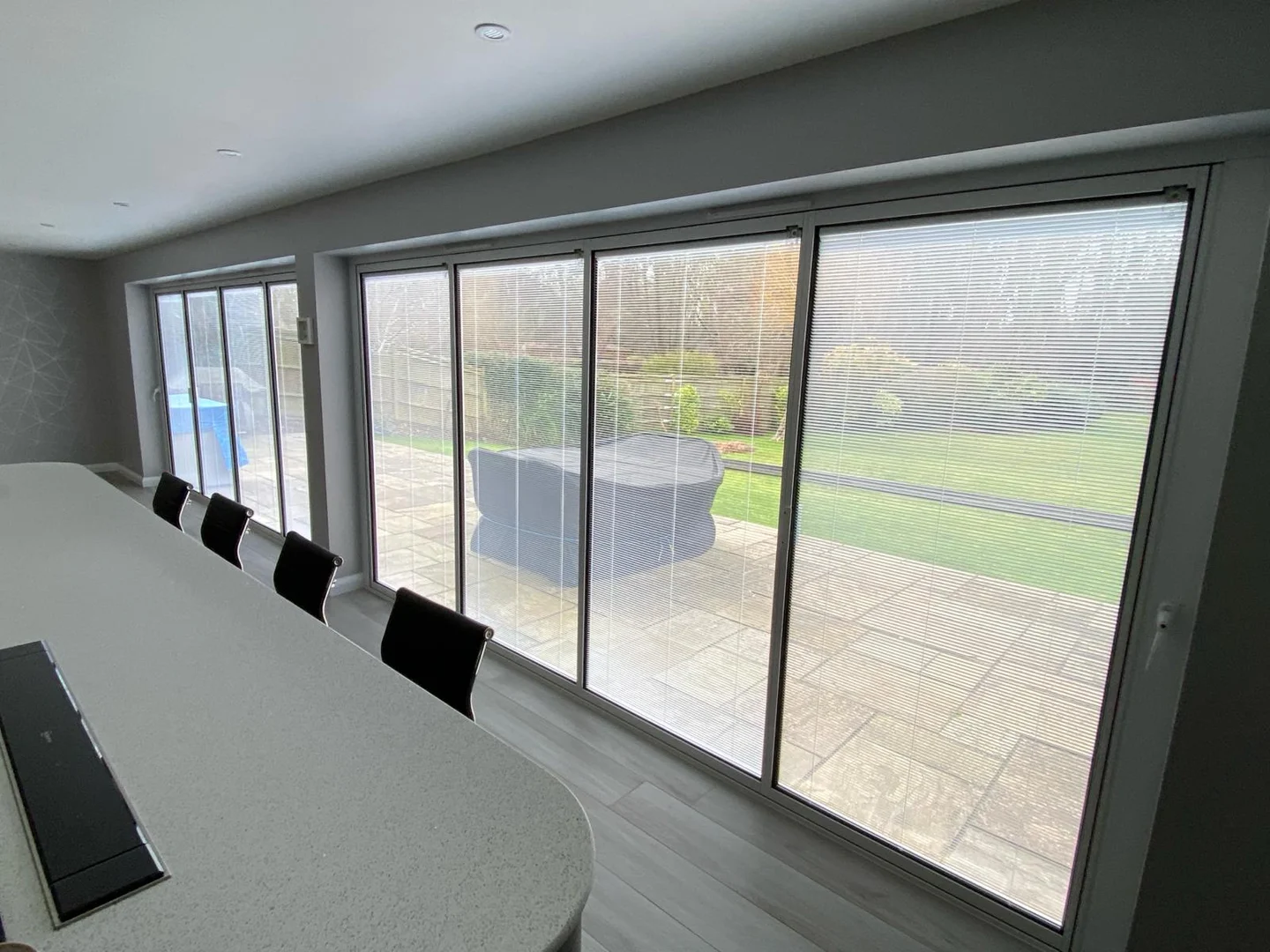
Modern Homes and Minimal Frames
Contemporary houses benefit from clean lines and minimal frame designs in their external concertina doors. Slim sightlines let glass dominate the view, with frames practically disappearing when doors are closed. The latest manufacturing techniques produce incredibly thin aluminium sections without sacrificing strength or weather protection.
Frameless corner systems remove visible supports at the junction between walls, opening up spectacular views. These use hidden structural elements to support the roof load while maintaining an ethereal, floating appearance. The glass-to-glass joints create nearly invisible divisions between panels.
Ultra-modern properties often incorporate oversize panels in their exterior concertina doors. Taller and wider glass sections reduce the number of visible frame lines, though they require robust hardware to operate smoothly. Advanced roller systems handle the increased weight without extra effort from users.
Glazing Innovations
New glass technologies improve thermal performance without compromising clarity. Solar control coatings cut summer heat gain while maintaining excellent light transmission. Some systems now incorporate electrochromic glass that changes opacity at the touch of a button, though this technology commands premium prices.
Period Properties and Traditional Styles
Victorian and Edwardian homes need external concertina doors that respect original architectural features. Wider frame profiles echo traditional timber proportions, while wood-effect finishes match existing joinery. Panel sizes typically run smaller than contemporary installations, maintaining historical proportions.
Georgian bars divide large glass areas into smaller panes, matching the aesthetic of original sash windows. True bars sit between glass panels rather than using stick-on grids, creating authentic shadow lines and depth. These details help bi fold conservatory doors integrate with older conservatory styles.
Heritage properties often incorporate decorative glazing patterns. Lead strips, coloured glass, and etched designs add character while maintaining modern thermal standards. Some manufacturers offer exact replicas of period glass patterns using modern safety glass.
Mixed Architectural Styles
Home extensions present unique challenges for external concertina door design. Modern garden room bifold doors can work well with period properties when frame styles bridge the gap between old and new. Careful material choices help recent additions complement original buildings without copying them exactly.
Glass extensions suit hybrid approaches to door design. Slim frames around large glass panels create contrast with solid masonry walls, highlighting the distinction between old and new construction. This intentional contrast often proves more successful than attempting to match period details exactly.
Split-level homes and unusual layouts need creative solutions for their external concertina doors. Stepped thresholds accommodate different floor levels while maintaining weather protection. Custom panels fit awkward spaces where standard sizes wouldn’t work.
Coastal and Rural Properties
Exposed locations demand robust external concertina doors with extra weather protection. Marine-grade finishes resist salt spray and intense UV exposure near the coast. Thicker glass units combat increased heat loss in windswept positions.
Rural properties often combine traditional appearances with modern performance. Wood-effect external concertina doors provide classic looks without the maintenance requirements of timber. Multi-point locking systems offer extra security in isolated locations.
Stone cottages and barn conversions need careful material selection. Raw metal finishes and industrial-style hardware complement exposed beams and rustic stonework. Slim frames avoid overpowering delicate period features while providing modern convenience.
About SunSeeker Doors
With over 20 years of experience, SunSeeker Doors remains at the forefront of door design with our quality-tested patio doors and related products, including the bespoke UltraSlim aluminium slide and pivot door system, Frameless Glass Doors, and Slimline Sliding Glass Doors. All of our doors are suitable for both internal and external use.
To request a free quotation, please use our online form. You may also contact 01582 492730, or email info@sunseekerdoors.co.uk if you have any questions.


